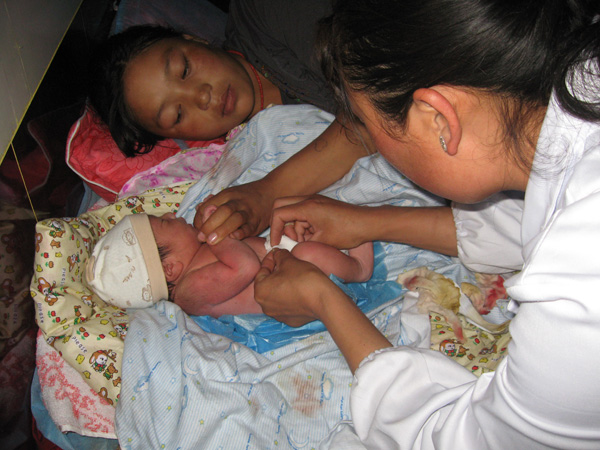Culture provides comfort in childbirth
By Xinhua in Tongren, Qinghai (China Daily) Updated: 2015-04-20 10:00
 |
|
A doctor attends to a newborn at the Tongren Natural Birth Center in Tongren county, Qinghai province. Provided to China Daily |
Private centers provide familiar atmosphere while increasing safety of Tibetan mothers
In China, where hospital childbirth is virtually universal, a growing number of Tibetan mothers-to-be are turning to natural birth centers as an alternative where they can access modern medical services while preserving their cultural traditions.
Private natural birth centers that emphasize cultural practices have proven appealing to Tibetan women in poor rural areas who are reluctant to let go of the tradition of giving birth at home, which can be risky without proper medical help, according to Drolkar Ja, an official in charge of health and family planning in Huangnan prefecture of Qinghai province.
In 2014, China met the Millennium Development Goals to reduce maternal mortality by 75 percent from 1990 levels, one year ahead of schedule. Now the pressure to improve delivery care and reduce maternal mortality comes from the country's ethnically diverse western interior, which faces a heavier task in poverty alleviation.
The maternal mortality rate in western China was 2.6 times more than in eastern areas in 2014, according to government data. The national average maternal mortality rate was 21.7 per 100,000 last year, a significant improvement over the 88.8 per 100,000 of 1990.
Lowering maternal mortality in poor, under-resourced rural regions to levels found elsewhere in the country is a challenge, and medical experts are recommending incorporating cultural practices to improve maternal care in less developed regions.
Tongren Natural Birth Center, the first of its kind for Tibetans, was launched by local gynecologist Tsering Kyi and Lama Kunchok Gyaltsen in August 2009 in Qinghai. According to Drolkar Ja, it is a good example for what should be done in the future.
Better choice
"The biggest obstacle to promoting hospital delivery in rural areas often comes from a family's mother-in-law, as it was normal for older generations to deliver three or four children at home back in the 1960s and 1970s. The belief is prevalant that pregnant women are not medical patients and do not need to go to hospitals for delivery, especially when there could be medical expenses incurred," Drolkar Ja said.
But at Tongren Natural Birth Center, it is not unusual to see a mother-in-law accompanying her expectant daughter-in-law during the childbirth process.
Dodan, an expectant mother from nearby Zeku county, gave birth at a local clinic in 2012. This time, she traveled 80 kilometers with her mother-in-law and husband to the center.
"Many of my friends referred me to this place. My mother-in-law also prefers this place. It is a better choice as the doctors and nurses speak Tibetan, and we can stay in homelike suites for a couple of weeks. Cooking and showering are very convenient. Monks also chant scripture during the birth," she said.
Rural women have been discouraged from hospital delivery for a number of reasons, including a lack of beds due to too many patients, extra expenses for family lodging, and Tibetan cultural prohibitions against men's involvement during pregnancy and childbirth, which leads to reluctance to be treated by male doctors.
"Many Tibetan women view pregnancy and childbirth as a normal process and see hospitals as places to treat illness and emergencies. Thus, going to a hospital to deliver a baby is counterintuitive," said Kunchok Gyaltsen, honorary president of Arura Hospital in Qinghai, who holds a doctorate in public health from the University of California at Los Angeles.
Tibetan women who have delivered at Tongren Natural Birth Center said they appreciated the large rooms with heated beds, the choice of traditional delivery options and the presence of their families during the birthing process.
The mothers also praised the center's adherence to cultural practices such as scripture chanting by Tibetan monks, placing amulets and Tibetan thangka paintings on the wall, and giving newborns butter pills.
"As the birth center offers a homelike atmosphere that helps expectant mothers relax, it is much easier for them to give up home birth traditions that can be highly dangerous to both the mother and child if they fail to access proper medical help in time," Tsering Kyi said.
In addition to the rural Tibetan women who make up the majority of its patients, the center has also received a few expectant mothers who are members of the Han and Hui groups in ethnically diverse Qinghai. In 2010, 53 percent of the province's residents were Han, 24 percent were Tibetans, 15 percent were Hui and 8 percent came from other ethnic groups.
- Govt encourages people to work 4.5 days a week
- Action to be taken as HIV cases among students rise
- Debate grows over reproductive rights
- Country's first bishop ordained in 3 years
- China builds Tibetan Buddhism academy in Chengdu
- Authorities require reporting of HIV infections at schools
- Typhoon Soudelor kills 14 in East China
- Police crack down on overseas gambling site
- Debate over death penalty for child traffickers goes on
- Beijing to tighten mail security for war anniversary







